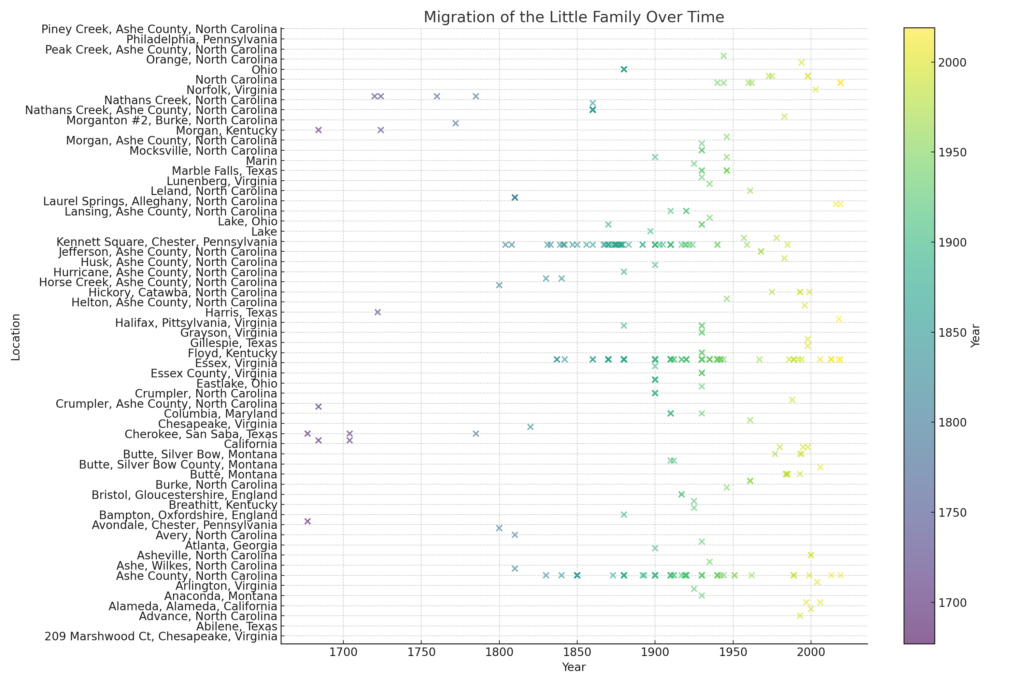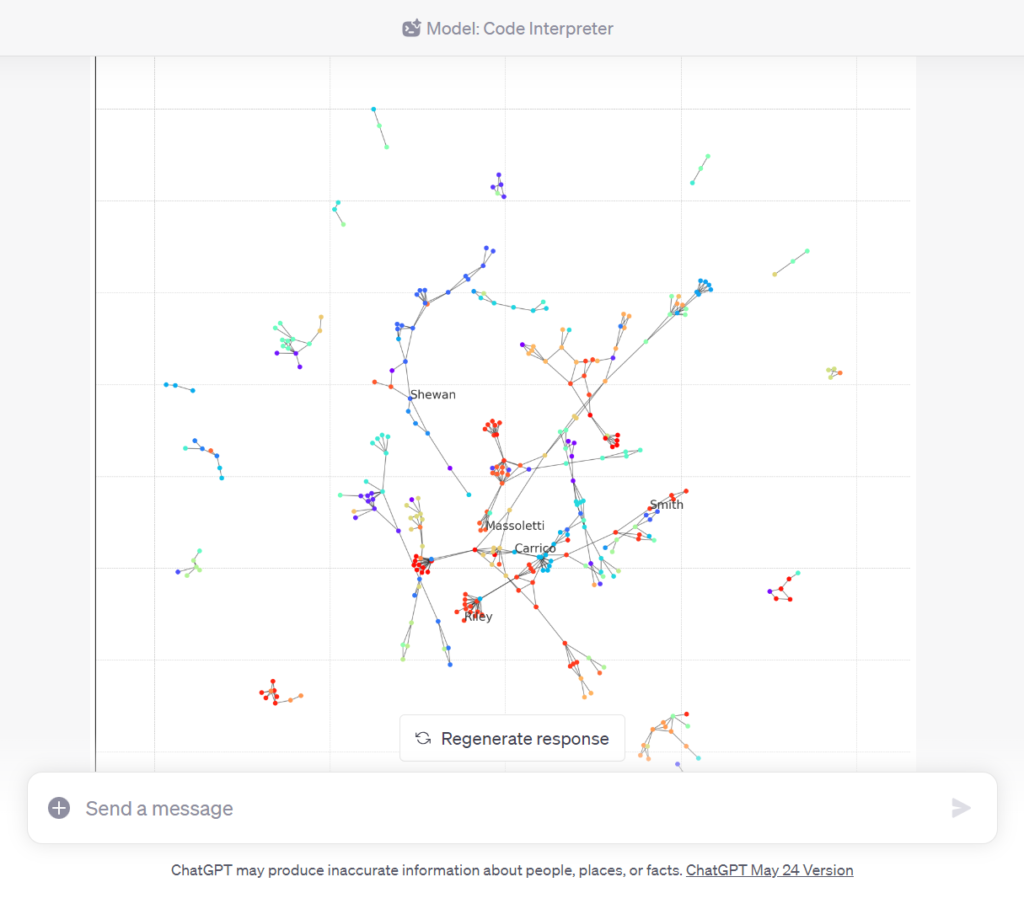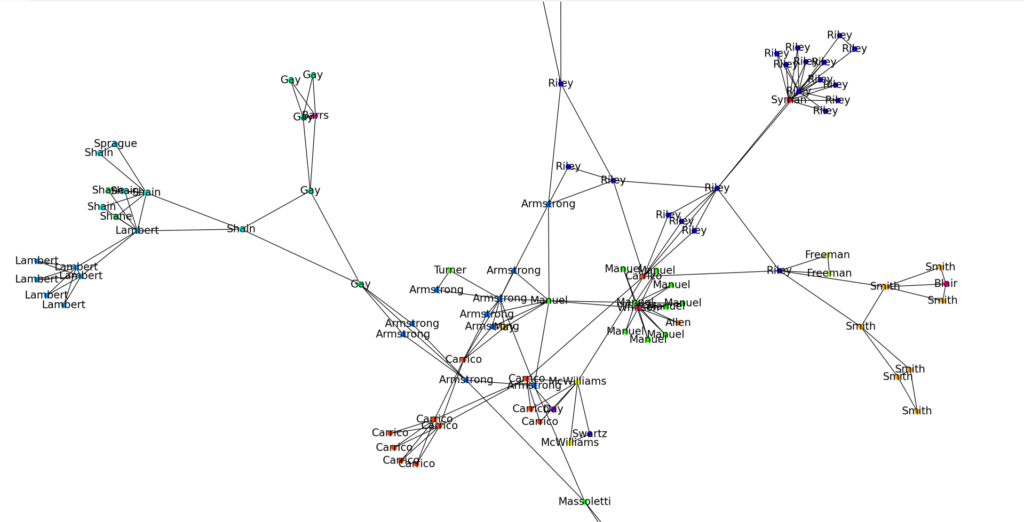New model eliminates hallucinations, shatters input limits, and much more
Key Points:
- OpenAI’s Code Interpreter is an advanced AI model for ChatGPT, offering the ability to execute code, analyze data, generate charts, and handle files. It can also interact with genealogical data and databases, serving as a potential tool for genealogists.
- The Code Interpreter helps address two significant challenges of earlier AI models: hallucinations and input limits. It operates solely on user-provided data, reducing chances of generating false information, and can handle large input files up to 100MB.
- The tool demonstrates proficiency in analyzing and visualizing genealogical data, as demonstrated through the GEDCOM file analysis and creation of a timeline for family migration.
- Code Interpreter can interact with personal genealogical databases such as RootsMagic, directly engaging with raw data and creating visual representations like network graphs to reveal community interconnectedness.
- Despite promising results, the Code Interpreter is in its early days of assessment, and user data security remains paramount. The feature is currently available only for paid ChatGPT Plus subscribers, with further refinements and exploration of its capabilities anticipated.
Introduction
Imagine stumbling upon a powerful tool that has the potential to revolutionize your genealogical exploration, a tool that could seamlessly dive into the intricate knots of your lineage, swim through the waves of complex data, and emerge with valuable insights. Your quest to understand your roots just became a lot more intriguing with OpenAI’s introduction of the “Code Interpreter” for ChatGPT on July 6, 2023.
Designed to elevate the prowess of the already sophisticated ChatGPT, the Code Interpreter is an advanced AI model imbued with capabilities beyond mere text generation and understanding. It facilitates an interactive workspace, allowing the execution of code, analysis of data, generation of charts, editing of files, and even complex calculations. But what sets it apart, especially for genealogists and heritage enthusiasts, is its potential to help decipher genealogical data like GEDCOM files and mine through genealogical databases.
With Code Interpreter, OpenAI offers an elegant solution to two primary challenges that earlier AI models faced – hallucinations and input limits. By ensuring that the AI operates solely on the data you provide, it significantly reduces the chances of ‘hallucination,’ where the AI might generate inauthentic information. Additionally, it can handle input files as large as 100MB, if not more, far exceeding its predecessors.
In this blog post, we take a first glimpse of Code Interpreter, as we begin unpacking the features of this powerful tool, provide a preliminary evaluation of its capabilities, and discuss potential precautions to keep in mind. We’ll also present a couple of genealogical tasks it can perform, shedding light on the immediate and exciting implications of this innovative technology. It will take weeks and months to chart the limits and benefits of this new ChatGPT model, so let’s get started.
More About Code Interpreter
OpenAI’s Code Interpreter is an innovative addition to its AI tool, ChatGPT. Imagine having a smart assistant that can not only understand your requests, but can also run complex analyses, manage files, and even generate charts. All of this is done within a safe and secure environment, providing peace of mind regarding your data’s integrity. The real charm of Code Interpreter lies in its ease of use – you don’t need any programming knowledge. It seamlessly writes and executes Python code based on your needs, working like an intelligent companion in a dynamic workspace. So, whether you want to crunch numbers or organize your files, Code Interpreter empowers ChatGPT to make your interactions more fruitful, efficient, and engaging, all without you having to write a single line of code.
Use Case 1: GEDCOM Analysis
Let’s start with GEDCOM files, a common data format for genealogy enthusiasts. Before Code Interpreter, handling these files with ChatGPT required a rather tedious process of copying and pasting data – a method only feasible for smaller files encompassing a few generations. Now, though, with the ability to upload files directly to Code Interpreter, we can analyze GEDCOM data on a much larger scale. As a test, I uploaded a GEDCOM file, weighing in at 1,741 KB, with information on roughly 3,500 individuals spanning more than ten generations. A diverse family tree of this size would have been a challenge previously, but Code Interpreter took it in stride.
In saying this, I should note that it wasn’t all smooth sailing. Engaging Code Interpreter with the GEDCOM file required persistence and some workarounds. GEDCOM is a unique format, needing to be read line-by-line as opposed to being treated as a structured data container. But once I got Code Interpreter on track, it proved capable of accurately answering various queries about the data.
Fascinated by Code Interpreter’s noted proficiency in data visualization, I attempted to coax it into charting the migration of my ‘Little’ ancestors. While I didn’t manage to extract a geographical map, Code Interpreter surprised me by producing a timeline of the places where the ‘Little’ family resided over centuries. Although this initial draft may not win any design awards, the potential it holds is thrilling. With a bit of tweaking and fine-tuning, this process could transform into a powerful tool for visualizing our ancestors’ journey through time. And, even if we cannot get Code Interpreter to create a map directly, the extracted place-date data can be exported to more sophisticated mapping tools.

This engagement with GEDCOM data left me curious: could Code Interpreter directly engage with a genealogical database such as RootsMagic, Family Tree Maker, or GRAMPS? Exploring this question opened a whole new can of possibilities, as we’ll see in the next section.
Use Case 2: Personal Genealogical Databases
After the mixed success of navigating GEDCOM files, I decided to engage Code Interpreter with my genealogical database software, RootsMagic. Instead of treating genealogical data as a mere transportation medium between systems, I aimed to access the source – the MySQL database where information is stored. The idea was to bypass the constraints of the GEDCOM format and see how Code Interpreter would handle the raw data.
I must admit, the initial success was exhilarating. Unlike the multiple attempts required with GEDCOM, Code Interpreter connected to the MySQL database quickly and began parsing the structure with ease. The interaction felt natural, intuitive, and even conversational – an unexpected, pleasant surprise.
To maintain privacy, I didn’t upload my primary database. Instead, I utilized a smaller database I maintain, documenting the 500-odd residents of a local village cemetery, many of whom were interrelated through two centuries of intermarriage. I wanted to visualize these connections, and so I tasked Code Interpreter with creating a network graph of the graveyard’s community interrelations.
My initial request returned a promising yet somewhat chaotic result. It required some refinement to achieve a clear and meaningful visual representation. However, after a few iterations, Code Interpreter was able to produce an insightful graph. It divided the deceased into 16 distinct clusters, with one particularly large, sprawling group standing out.

To describe our back-and-forth, I first asked Code Interpreter to construct a network graph. We hit a couple of roadblocks early on due to overlooking some data structure intricacies and labeling issues, but Code Interpreter handled these issues remarkably well. Each misstep was met with patient re-evaluation, followed by refined attempts. As we iterated, my companion made changes according to my feedback: focusing on the largest family group, providing unique colors for each surname, ensuring that the complete data could be re-created if needed.
Despite the initial hiccup with labeling, we finally got a striking visualization. The final network graph, color-coded and clean, revealed the interconnectedness of the community in a way that tables or lists of names could never accomplish.

To sum up, Code Interpreter turned a potentially tedious task into a conversational and interactive learning journey. It had its share of stumbles, but I found it surprisingly adaptable and willing to learn from its mistakes. Even though the network graph needed some fine-tuning, the process’s simplicity and potential were promising.
This successful experience with a personal genealogical database invigorated me. I am ready to push the boundaries further and explore Code Interpreter’s capability with other formats – specifically, scanned historical documents. The results, as we will see in my next post, are fascinating.
Conclusion
In our exploratory journey, we’ve found that OpenAI’s Code Interpreter for ChatGPT offers exciting new possibilities for genealogical work. We’ve witnessed it tackle GEDCOM files, interact with personal genealogical databases, and handle complex tasks such as generating visualizations, all while preserving user data security. A significant observation was that the AI did not hallucinate or make things up when only user data was provided, marking a crucial development. In addition, the input limit has been drastically increased, accommodating files as large as 100MB.
Nonetheless, these are still early days of assessment, and this evaluation is not meant to serve as a comprehensive guide. These proof-of-concept applications merely scratch the surface of what this tool can do. It’s also important to note that, at this stage, the Code Interpreter feature is only available for paid subscribers to ChatGPT Plus.
We should also remember that while ChatGPT Plus provides privacy controls, ensuring data security ultimately rests with us. We recommend turning off chat history and chat training to safeguard your genealogical data.
The future is bright, and the possibilities seem endless. We expect a flurry of new use-cases to emerge as genealogists and enthusiasts experiment with this technology. This early assessment merely hints at what’s to come. Code Interpreter is a powerful new ally in our quest to unravel the mysteries of our past, and we look forward to refining our techniques to unlock its full potential.
One thought on “First Blush: ChatGPT’s Code Interpreter a Giant Leap Forward”
Comments are closed.